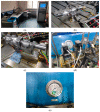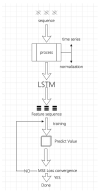Direct-Drive Electro-Hydraulic Servo Valve Performance Characteristics Prediction Based on Big Data and Neural Networks
- PMID: 37631748
- PMCID: PMC10459400
- DOI: 10.3390/s23167211
Direct-Drive Electro-Hydraulic Servo Valve Performance Characteristics Prediction Based on Big Data and Neural Networks
Abstract
Direct-drive electro-hydraulic servo valves play a key role in aerospace control systems, and their operational stability and safety reliability are crucial to the safety, stability, and efficiency of the entire control system. Based on the prediction of the performance change of the servo valve and the resulting judgement and prediction of its life, this can effectively avoid serious accidents and economic losses caused by failure due to performance degradation in the work. On the basis of existing research, factors such as opening, oil contamination, and pressure difference are used as prerequisites for the operation of direct-drive electro-hydraulic servo valves. In addition to the current research on pressure gain and leakage, the performance parameters of servo valves, such as overlap, threshold, and symmetry, are also expanded and selected as research objects, combined with pressure design servo valve performance degradation experiments for testing instruments such as flow and position sensors, and data are obtained on changes in various performance parameters. The experimental data are analyzed and a prediction model is built to predict the performance parameters of the servo valve by combining the existing popular neural networks, and the prediction error is calculated to verify the accuracy and validity of the model. The experimental results indicate that as the working time progresses, the degree of erosion and wear on the valve core and valve sleeve of the servo valve increases. Overall, it has been observed that the performance parameters of the servo valve show a slow trend of change under different working conditions, and the rate of change is generally higher under high pollution (level 9) conditions than under other conditions. The prediction results indicate that the predicted values of various performance parameters of the servo valve by the prediction model are lower than 0.2% compared to the experimental test set data. By comparing the two dimensions of the accuracy and prediction trend, this model meets industrial needs and outperforms deep learning algorithm models such as the exponential smoothing algorithm and ARIMA model. The experiments and results of this study provide theoretical support for the life prediction model of servo valves based on neural networks and machine learning in artificial intelligence, and provide a reference for the development of direct-drive electro-hydraulic servo valves in aerospace and other industrial fields for use and failure standards.
Keywords: direct-drive electrohydraulic servo valves; erosive wear; machine learning; neural networks; performance degradation.
Conflict of interest statement
The authors declare no conflict of interest.
Figures

























References
-
- Huang Y. Discussion on the Teaching Reform of <Sensor Technology and Application> in Local Application-oriented Undergraduate University. Off. Informatiz. 2022;27:44–46. (In Chinese)
-
- Chen Y. The Initial Design Concept and Applications for the Electrohydraulic Servovalve. Mach. Tool Hydraul. 2019;47:114–118. doi: 10.3969/j.issn.1001-3881.2019.09.024. (In Chinese) - DOI
-
- Wang H.-B., Huang Z., Liu Z., Gao B., Xv Y., Yu B. Life analysis of electro—Hydraulic servo valve based on FMMEA. J. Mech. Electr. Eng. 2022;39:1132–1137. doi: 10.3969/j.issn.1001-4551.2022.08.015. (In Chinese) - DOI
-
- Hu Q., He Q., Cao L. IHHO-LSSVM Rolling Bearing Life Prediction Model Treated by EEMD-KPCA. J. Huaqiao Univ. (Nat. Sci.) 2022;43:145–153. doi: 10.11830/ISSN.1000-5013.202012025. (In Chinese) - DOI
-
- Zhang Y., Tang B., Xiong P. Rolling element bearing life prediction based on multi-scale mutation particle swarm optimized multi-kernel least square support vector machine. Chin. J. Sci. Instrum. 2016;37:2489–2496. doi: 10.19650/j.cnki.cjsi.2016.11.011. (In Chinese) - DOI
Grants and funding
LinkOut - more resources
Full Text Sources
Other Literature Sources

